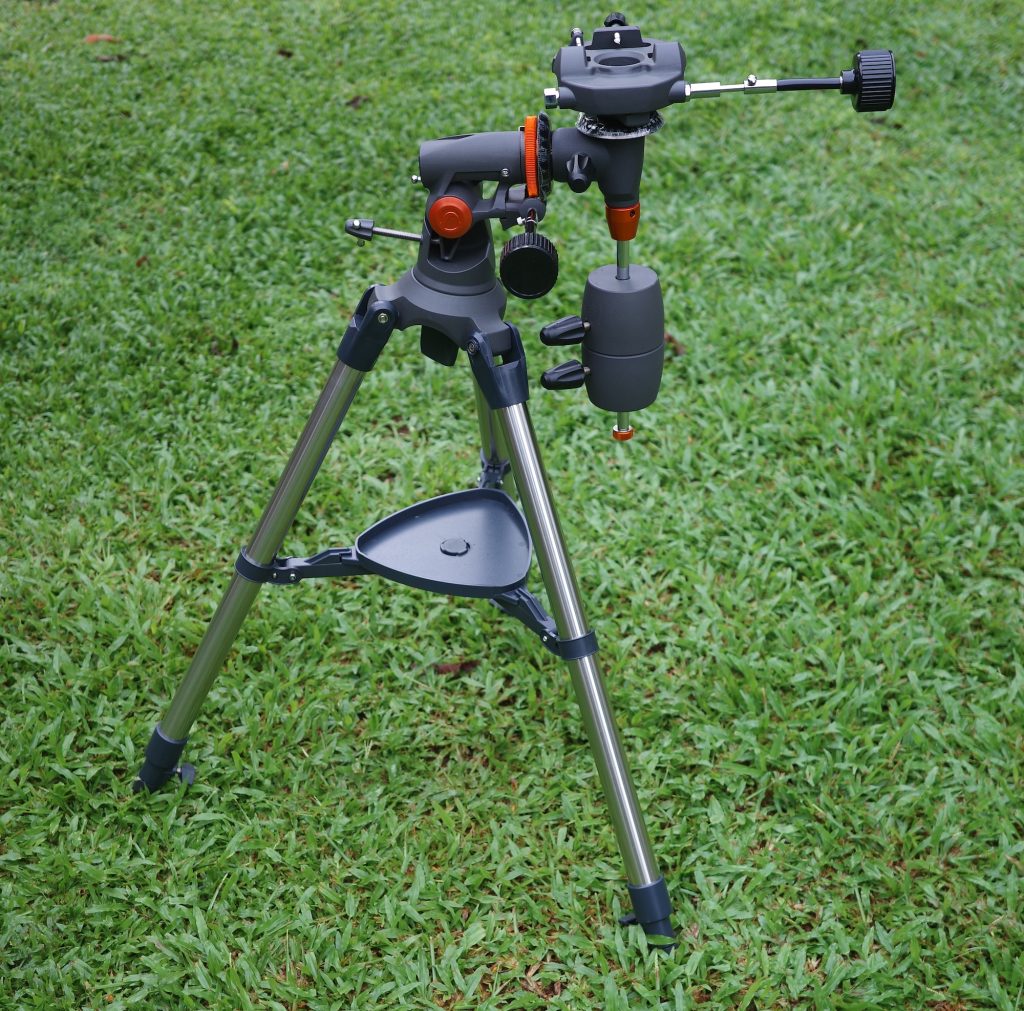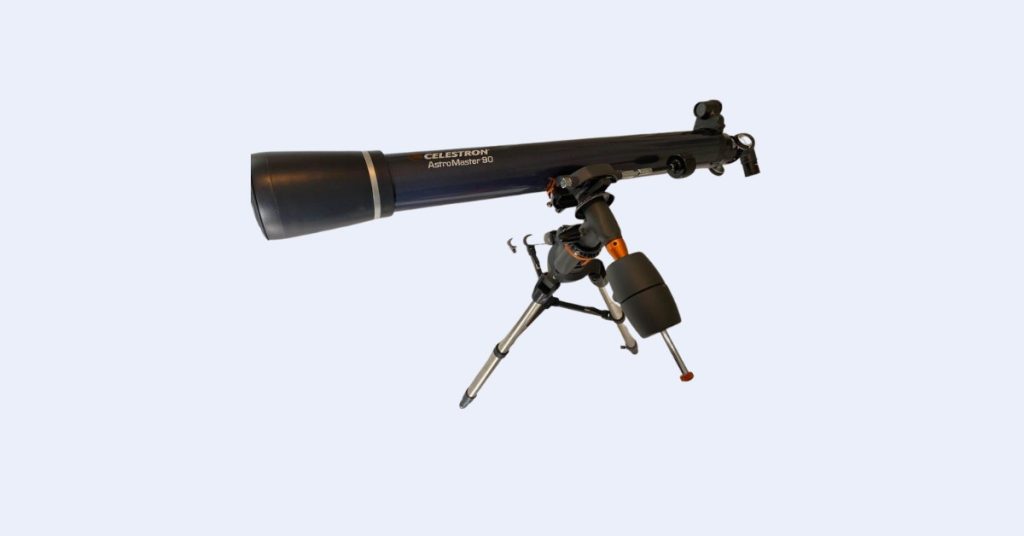The Optical Tube
The Celestron AstroMaster 90AZ is a 90mm (3.5”) achromatic refractor telescope with a focal length of 1000mm and an f/11 focal ratio.
An achromatic refractor uses a lens with two separate pieces of crown and flint glasses to keep chromatic aberration under control, which the 90AZ does well on all except the brightest targets, such as the Moon, planets, and the brightest stars. Chromatic aberration still manifests in the 90AZ on these targets as a slight bluish-purple halo, but the telescope has no trouble providing sharp details on Solar System objects, and stars appear as pinpoints.
Like most refractors, the AstroMaster 90AZ has a built-in dew shield at the front end to prevent condensation from forming on the objective lens and reduce the worst sources of stray light and glare, as well as baffles within the tube to help with eliminating glare and internal reflections.
Many of the fittings on the 90AZ’s optical tube are made of plastic, including the built-in 1.25″ rack and pinion focuser, which is adequate if a bit wobbly and prone to sagging with heavier eyepieces and accessories.
Mounting Options and Dovetail Compatibility
The bottom of the AstroMaster 90AZ’s optical tube has a Vixen-style dovetail plate fitted to it with ¼ 20 holes drilled to mount it to photo tripod fittings.
The universal design of the Vixen-style dovetail allows you to attach the 90AZ to any quality astronomical telescope mount with a Vixen-style dovetail saddle, should you somehow manage to find a decent replacement that costs less than the 90AZ itself.
The plate is too short to allow you to slide the tube for balance with heavier accessories attached to the back, but this is unlikely to be much of a problem.
The Somewhat Useful Set of Accessories
The Celestron AstroMaster 90AZ refractor telescope comes with a 1.25” Amici prism diagonal designed for terrestrial viewing.
The Amici prism design produces an image that’s corrected left-right, so I can, for example, read distant text. Aside from the obvious impracticality of using the awkward and long 90AZ refractor for terrestrial observations, the Amici design inherently produces more glare and an annoying diffraction spike on bright objects.
The cheap design of Celestron’s Amici prism means it’s also undersized, which results in vignetting with low-power eyepieces. Additionally, the low-quality optical coatings and plastic body of the star diagonal lead to internal reflections, glare, and a generally less-than-sharp image.
- While bottlenecked in performance by the provided Amici prism, the 20mm (50x magnification) and 10mm (100x magnification) 1.25” 3-element eyepieces included with the 90AZ felt decent enough to me, with glass optics and a sharp 50-degree apparent field of view.
The 20mm 3-element provides a true field of 1 degree, or about twice the angular diameter of the full Moon in the sky. However, the 50x magnification is a bit much for a low-power eyepiece. I imagine that the likely explanation for its inclusion is that anything providing a lower magnification and wider field than the 20mm 3-element eyepiece would simply vignette with the Amici prism.
- The AstroMaster 90AZ comes with a generic battery-powered “StarPointer” red dot sight to aim the telescope.
I had the impression that these finders are great, but the bracket used to attach the finder to the telescope is not very stiff and can sometimes be bent or warped to the point that the finder cannot be aligned with the telescope at all. I figure this is a consequence of the fact that the current StarPointer is a replacement for an earlier, low-quality sight that Celestron stopped putting on the AstroMaster telescopes.
If you can get the red dot finder aligned with the 90AZ, it makes aiming a breeze. If you can’t, using the telescope becomes even more frustrating when combined with its shoddy, jerky mount.
The Part That I Don’t Like: AstroMaster AZ Mount
The mount provided with the Celestron AstroMaster AZ telescopes, including the 90AZ, is essentially a glorified photo tripod head attached to a tripod borrowed from the CG-3 equatorial mount sold with the AstroMaster telescopes, so if you ever need spare parts for a CG-3, you can always cannibalise an AstroMaster AZ mount, which is probably the most useful thing you can do with it.

Like the CG-3, a lot of the fittings on the tripod are plastic, and a universal Vixen-style dovetail saddle is used to grip the optical tube.
The AstroMaster AZ mount head is a simple alt-azimuth design that pivots up-down, left-right. The only fine adjustment control of any kind is a handle that also serves to lock the altitude axis, and a clutch for the azimuth axis. There are no fine adjustment controls of any kind, which itself wouldn’t be a problem for a low-power, wide-field instrument but is a huge issue for a telescope of 1000mm focal length.
This is exacerbated by the fundamental reason why photo tripod heads and similarly designed mounts are bad for astronomical telescopes: The fact that the telescope rides above the altitude axis of the AstroMaster AZ mount means it is both extremely top-heavy and inherently unbalanced.
With a long telescope like the 90AZ optical tube, the mount will pretty much never be able to stay in place without the altitude axis being almost completely locked, which makes fine motion downright impossible. It is also just shaky to begin with. As such, the AstroMaster AZ mount is the weakest link in an already mediocre instrument and completely kills its usability, making for a frustrating experience at best.
Should I buy a Used Celestron AstroMaster 90AZ?
A used Celestron AstroMaster 90AZ refractor telescope is not a good deal unless you can find a used mount that’s cheap and sturdy enough to work with it.
The optical tube is great, but a suitable new mount usually costs more than a simply superior new telescope. There is thankfully little that can go wrong with a used one apart from missing accessories, obvious damage to the objective lens, or cracks in any plastic parts.
Alternative Recommendations
The Celestron AstroMaster 90AZ is a pretty bad pick, even if it were sold at half-price. Here are a few of the telescopes I recommend instead.
Under £250
- The Sky-Watcher Heritage 130P provides a significant leap in capability over smaller 114mm and 100mm reflectors and vastly outpaces the AstroMaster 90AZ in all types of viewing. The tabletop Dobsonian mount is simple and sturdy, while the collapsable tube makes transport and storage a breeze.
- The Zhumell Z114/Orion StarBlast 4.5 Astro has significantly more light-gathering power than the AstroMaster 90AZ, a wider field of view, and comes with a steady, easy-to-use tabletop Dobsonian mount.
- The Zhumell Z100/Sky-Watcher Heritage 100P is on par with the AstroMaster 90AZ in light collecting ability and resolution, but the mere 400mm focal length provides a much wider field of view ideal for viewing deep-sky objects and the tabletop Dobsonian mount is steady as well as ultra-portable.
- The Celestron StarSense Explorer LT 80AZ Refractor has a slightly better mount than the AstroMaster 90AZ, with the bonus of being able to use Celestron’s StarSense Explorer technology to assist in aiming around the sky – however, the limitations of small aperture and long focal length remain.
£250-£325
- The Sky-Watcher Heritage 150P shares its design and accessories with the Heritage 130P but with an even larger 150mm aperture for more light-collecting and resolving power.
- The Popular Science Celestron StarSense Explorer DX 100AZ Refractor has a short focal length and thus a fair amount of chromatic aberration, but uses a well-designed alt-azimuth mount with fine adjustments, provides a much wider field of view and slightly more aperture than the AstroMaster 90AZ for superior deep-sky views, and pointing is assisted by your smartphone coupled with Celestron’s StarSense Explorer technology.
What can you see with Astromaster 90AZ Refractor?
The Celestron AstroMaster 90AZ’s mount means it is really limited to low magnifications. Unfortunately, its long focal length means that it is severely constrained in reaching low magnifications and achieving a wide field of view.
- Its 90mm aperture is insufficient to reveal globular star clusters, planetary nebulae, or most visible galaxies as anything more than faint fuzzies devoid of detail.
- Open star clusters look great, but many of the largest and most spectacular ones simply do not fit in the 90AZ’s constrained field of view, particularly if I’m using the stock 20mm Kellner eyepiece.
- Bright emission nebulae like the Orion Nebula (M42) or the Lagoon (M8) are pleasing but far from the jaw-dropping appearance they achieve in larger instruments under dark skies.
- I could also split many thousands of double stars with the AstroMaster 90AZ, provided I can find them and keep them in my field of view at high magnification.
The AstroMaster 90AZ’s high-quality objective lens makes it ideal for viewing the Moon and planets, but the provided mount is a major limitation, especially at high powers where shakiness becomes even more evident and frequent adjustments are needed to track objects.
- The phases of Mercury are often hard to see, particularly with a less-than-steady mount and small aperture, but can just barely be glimpsed on a good night.
- Venus’ phases are easy to spot at low power with the 90AZ, and the Moon delights with countless details at almost any magnification or phase.
- You might be able to make out the polar ice cap on Mars with the AstroMaster 90AZ and perhaps even a few dark markings when the planet is at its closest to Earth.
- Jupiter’s moons, cloud bands, and the Great Red Spot can be seen, and you can sometimes resolve the disks of the moons and their shadows when they transit across Jupiter.
- The beautiful rings of Saturn are evident, along with the Cassini Division in the rings, a few moons, and Saturn’s dull cloud bands.
- Uranus and Neptune are too small and distant to see as much more than bluish smudges with the AstroMaster 90AZ and their moons are too dim to view at all, as is Pluto, which requires a telescope more than triple the size of the AstroMaster 90AZ to be viewed at all.


